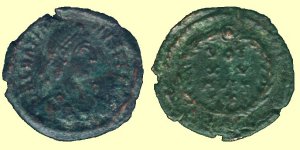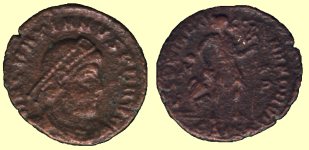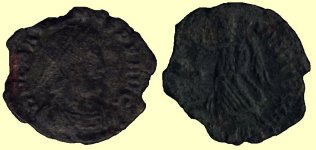
Gratian 367 - 383 A.D.
By clicking on the pictures you'll be linked to a more complete description of the coin. At the bottom of this page there is a more elaborate biography of the emperor.
 |
Obverse: DN GRATIANVS PF AVG |
| Reverse: VOT XV MVLT XX | |
|
Fieldmarks: -
|
|
| Exergue: - |
 |
Obverse: DN GRATIANVS PF AVG |
| Reverse: GLORIA ROMANORVM | |
|
Fieldmarks: a
|
|
| Exergue: ΔSISC |
 |
Obverse: DN GRATIANVS PF AVG |
| Reverse: SECVRITAS REIPVBLICAE | |
|
Fieldmarks: -
|
|
| Exergue: - |
Gratian 367 - 383 A.D.
Flavius Gratianus was born
on the 18th of April 359 at Sirmium
as the son of the emperor Valentinian I and
Marina Severa. He was awarded the consulate
of 366 along with Flavius Dagalaifus. In 367, he accompanied his father on his
campaign against the Alamanni
in Gaul,
where Valentinian was stricken with a mysterious illness. When it appeared that
the emperor would die, an immediate scramble ensued to pick his successor. The
imperial court championed the magister
memoriae Rusticus Julianus, while the army supported the magister
equitum Severus. Valentinian, however, recovered
and at Ambiani
in 367 AD he designated Gratian as his successor by proclaiming him co-Augustus.
By performing this act, Valentinian hoped to prevent a future recurrence of
the infighting between the imperial court and the senior officer corps over
his successor, thus ensuring a smooth transfer of power upon his death, and
keeping the imperial office within his family. There was some concern about
the choice of Gratian, however, both among the army and by Valentinian himself.
Unlike his father and uncle Valens, the young Gratian
(he was only eight at the time) did not show any talent towards being a skilled
soldier, being more interested in reading and studying than the art of war.
Valentinian brought Gratian with him during the campaigning season of 368, but
after it became clear that Gratian was not up to the rigors of military life,
Valentinian kept him behind the front lines.
In November 375 Valentinian
died at Brigetio,
leaving Gratian as senior Augustus in the west. Valentinian’s wish for
a smooth succession, however, was not realized. Gratian's lone reign lasted
for a mere five days, after which his brother Valentinian II was hailed CO-Augustus
at Aquinicum
this happened without the agreement or knowledge of Gratian and his court. Valentinian
I’s fear was realized: Gratian, at about 16 years of age, was no warrior,
and was thus not an acceptable imperial candidate to the soldiers. In contrast,
the young Valentinian, being only four years of age at the time of his father’s
death, could be vested with the imperial title, allowing the generals a continued
free reign. Gratian accepted Valentinian II’s elevation in a graceful manner,
even seeing to his half-brother’s education. Gratian controlled Gaul,
Britain,
and Spain,
while the court of Valentinian II controlled Illyricum,
Africa,
and Italy.
In 376, the emperor Valens requested Gratian’s help in defeating the Visigoths, who were in revolt in Thracia. Gratian sent several legions, but Merobaudes (one of Gratian's leading generals, probably magister peditum) disobeyed and left some legions to guard the borders against the Alamanni, should they decide to attack in the absence of troops. This was another indication that Gratian was not held in high esteem by his generals. In 381 Gratian moved his capital from Treverorum to Mediolanum. The situation in the east, however, grew so serious that it demanded Gratian’s presence, he left for the east in late 377 but was delayed by a renewed Alamannic invasion in February of 378. This attack was precipitated when a barbarian from his court leaked word of the pending withdrawal of Roman troops from Gaul. Merobaudes' prior decision to leave troops behind prevented a disaster, and Gratian’s army won a huge victory at Argentaria, killing nearly 35,000 Alamanni.
The historian Ammianus gives a nice report of this battle in which he describes that the invading army was completely made up of the southernmost branch of the Alamanni called the Lentienses (this entire tribe went to war) and that the roman soldiers where seriously outnumbered. However as soon as the enemy started their terrifying warcries the roman trumpets immediately ordered the attack. Under the initial hail of spears and arrows a lot of Romans and Alamanni died. Only in the heat of battle did the Romans realize how many of the enemy there actually were and they retreated and dispersed themselves trough the many orchards in the region to avoid a fight in the open. The Lentienses apparently got confused by the sparkling of all the roman armor in between the trees and they thought the Emperor himself with his imperial guard had arrived and a lot of them got scared and fled after which they where totally and utterly defeated. Apparently only 5000 of the original 40000 invaders survived this massacre, they where pursued but retreated high into the mountains to save what was left of their tribe. After a short but bloody siege they surrendered and begged forgiveness which was granted in exchange for their able bodied young men who would serve in the Roman army.
With the western provinces temporarily secured Gratian set out for the east but before he could arrive Valens made the decision to attack the Visigoths at Adrianopolis, not wanting to share a possible victory with Gratian. Another vision is that Gratian delayed his assistance intentionally, in order to see Valens out of the way, as he resented his uncle's claim to be senior Augustus. The battle, which occurred on the 9th of August 378, was a disaster, with Valens and most of the eastern army killed. Gratian, not being the military leader that his uncle or father had been, found himself in serious trouble as the Visigoths ravaged Thracia unopposed. In response to the crisis, Gratian recalled the younger Theodosius (his wife's cousin) from Spain to take command of the eastern armies. After Theodosius had some initial successes, Gratian proclaimed him as Augustus of the east on the 19th of January 379 and returned to the west. In 380 Gratian joined Theodosius in further campaigns along the Danube, resulting in the settlement of some Visigoths and Alans in Panonnia.
Gratian was an orthodox Christian which can be seen in his dealings with the senatorial aristocracy in Rome. In 382, at the urging of Ambrose (a very influential bishop from Mediolanum), he removed the Altar of Victory from the Forum and withdrew the state subsidies that funded many pagan activities. This was a crucial blow to one of the last major groups which supported Rome’s pagan heritage. When the Senate protested, Gratian rejected the honorary title of pontifex maximus and the ceremonial robes that went with this office being the first emperor to ever reject the title. Gratian lost his support from the army when he angered the regular legions by bringing in a group of Alans as his personal bodyguard and giving them special privileges. Soon after this Gratian’s career was ended by the usurper Magnus Maximus. In early 383 Gratian went north to fight another incursion of the Alamanni. While Gratian was weakened by this battle, Maximus was acclaimed Augustus by his troops in Britain, where he was comes Britanniae he crossed into Gaul to challenge Gratian. After a short period of skirmishing, Gratian’s Moorish cavalry, followed by most of his other troops, went over to Maximus. The emperor fled and tried to reach the Alps, but a senior officer joined them at Lugdunum, claiming to be one of his remaining supporters. The officer's name was Andragathius and in truth he was one of Maximus' men. Having managed to get close to Gratian he waited for the right opportunity and assassinated him in August of 383 AD.
For this biography I've used the texts from the following websites:
http://www.imperiumromanum.com/
http://www.roman-emperors.org/
http://www.roman-empire.net/
And from: Gibbon's Decline and fall of the Roman empire.